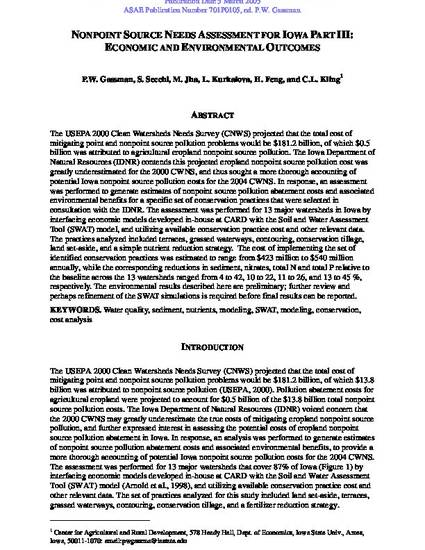
The USEPA 2000 Clean Watersheds Needs Survey (CNWS) projected that the total cost of mitigating point and nonpoint source pollution problems would be $181.2 billion, of which $0.5 billion was attributed to agricultural cropland nonpoint source pollution. The Iowa Department of Natural Resources (IDNR) contends this projected cropland nonpoint source pollution cost was greatly underestimated for the 2000 CWNS, and thus sought a more thorough accounting of potential Iowa nonpoint source pollution costs for the 2004 CWNS. In response, an assessment was performed to generate estimates of nonpoint source pollution abatement costs and associated environmental benefits for a specific set of conservation practices that were selected in consultation with the IDNR. The assessment was performed for 13 major watersheds in Iowa by interfacing economic models developed in-house at CARD with the Soil and Water Assessment Tool (SWAT) model, and utilizing available conservation practice cost and other relevant data. The practices analyzed included terraces, grassed waterways, contouring, conservation tillage, land set-aside, and a simple nutrient reduction strategy. The cost of implementing the set of identified conservation practices was estimated to range from $423 million to $540 million annually, while the corresponding reductions in sediment, nitrates, total N and total P relative to the baseline across the 13 watersheds ranged from 4 to 42, 10 to 22, 11 to 26, and 13 to 45 %, respectively. The environmental results described here are preliminary; further review and perhaps refinement of the SWAT simulations is required before final results can be reported.
Available at: http://works.bepress.com/hongli-hennessy/56/

This proceeding is published as Gassman, P. W., S. Secchi, M. Jha, L. Kurkalova, H. Feng, and C. L. Kling. "Nonpoint source needs assessment for Iowa part III: economic and environmental outcomes." In Watershed Management to Meet Water Quality Standards and Emerging TMDL, 5-9 March 2005, Atlanta, Georgia, p. 533. American Society of Agricultural and Biological Engineers, 2005. doi:10.13031/2013.18115. Posted with permission.